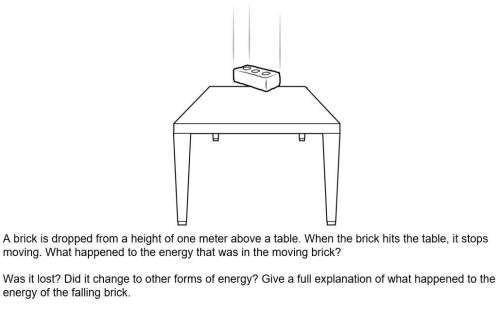What happened to the energy that was in the moving brick?
was it lost?
d...

Physics, 12.11.2019 02:31 alisonlebron15
What happened to the energy that was in the moving brick?
was it lost?
did it change to other forms of energy?
a simple yes or no to each question will do! you


Answers: 1


Other questions on the subject: Physics


Physics, 22.06.2019 02:00, llamasking
Chapter 23, problem 075 the figure shows a geiger counter, a device used to detect ionizing radiation (radiation that causes ionization of atoms). the counter consists of a thin, positively charged central wire surrounded by a concentric, circular, conducting cylindrical shell with an equal negative charge. thus, a strong radial electric field is set up inside the shell. the shell contains a low-pressure inert gas. a particle of radiation entering the device through the shell wall ionizes a few of the gas atoms. the resulting free electrons (e) are drawn to the positive wire. however, the electric field is so intense that, between collisions with gas atoms, the free electrons gain energy sufficient to ionize these atoms also. more free electrons are thereby created, and the process is repeated until the electrons reach the wire. the resulting "avalanche" of electrons is collected by the wire, generating a signal that is used to record the passage of the original particle of radiation. suppose the radius of the central wire is 24 âµm, the inner radius of the shell 2.3 cm, and the length of the shell 14 cm. if the electric field at the shell's inner wall is 2.8 ă— 104 n/c, what is the total positive charge on the central wire?
Answers: 1

Physics, 22.06.2019 11:30, slim2077
Two 1.20-m nonconducting wires meet at a right angle. one segment carries + 2.50 µc of charge distributed uniformly along its length, and the other carries - 2.50 µc distributed uniformly along it, as shown in fig. 21.50. ( a. find the magnitude and direction of the electric field these wires produce at point p, which is 60.0 cm from each wire. ( b. if an electron is released at p, what are the magnitude and direction of the net force that these wires exert on it?
Answers: 3

Physics, 22.06.2019 15:00, tinagibbs98
10 points! will mark brainiest! in a heat engine if 1,000 j of heat enters the system and the piston does 500 j of work, what is the final internal energy of the system if the initial energy was 2,000 j 1: write the equation 2: list out your known variables 3: plug the numbers into the equations 4: solve 5: write your solution statement that includes initial energy and final energy added you so much!
Answers: 3
You know the right answer?
Questions in other subjects:



History, 18.12.2020 01:00

History, 18.12.2020 01:00

Mathematics, 18.12.2020 01:00



History, 18.12.2020 01:00





